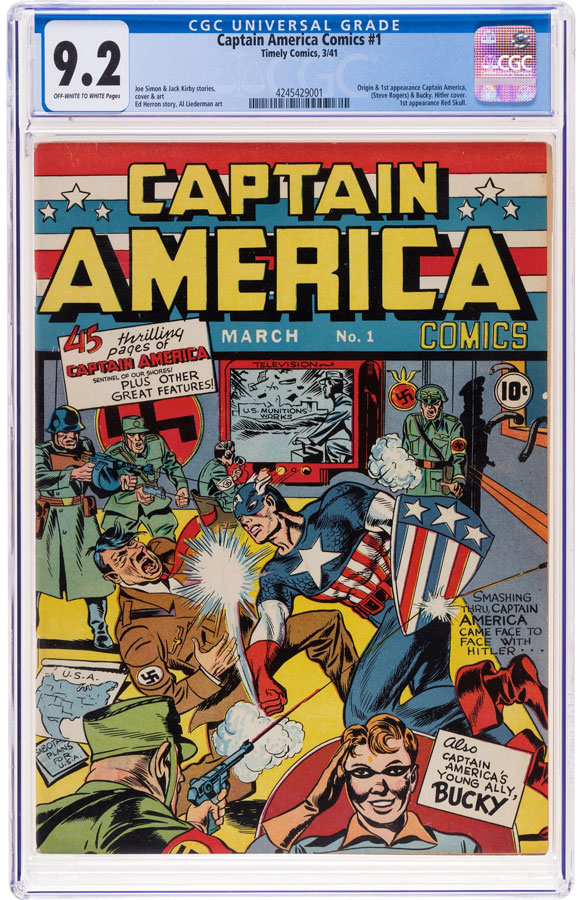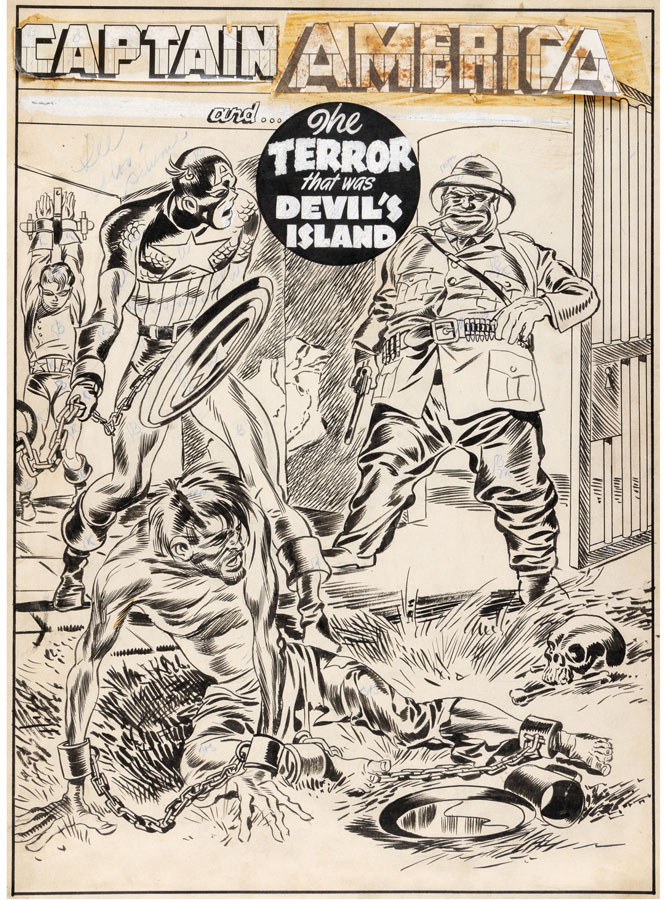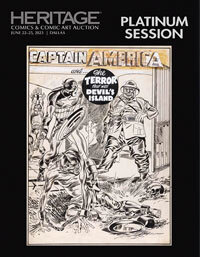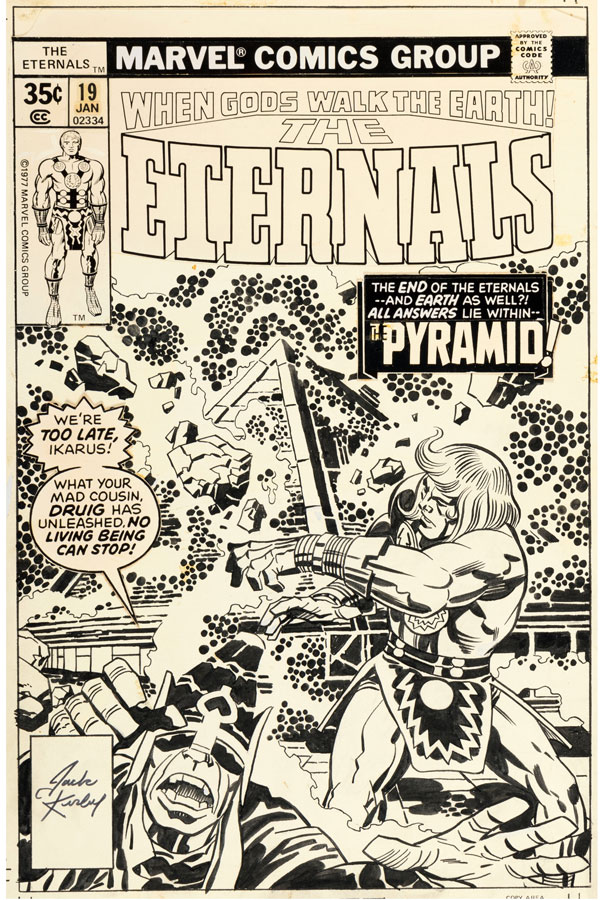HOW A PAIR OF SCRAPPY YOUNG COMIC BOOK MAKERS CREATED ONE OF THE BEST-SELLING SUPERHEROES OF ALL TIME
By Robert Wilonsky
At any given moment, Heritage Auctions offers hundreds – maybe thousands – of comic books Jack Kirby wrote and illustrated, among them some of the most famous, influential and adored titles in the medium’s relatively brief history. They span decades, genres, publishers; they feature newsboy legions and mutant teens, young lovers and new gods, war heroes and alien invaders. The man born Jacob Kurtzberg in New York in 1917 isn’t called King Kirby for nothing: “He combined the virtues and limitations of his class with a stubborn genius to produce a body of comics work that has remained consistently true to its source and is unparalleled both in quantity and quality,” Gary Groth wrote when introducing Kirby for his legendary Comics Journal interview.
Jerry Siegel and Joe Shuster gave us Superman, the first superhero. But Jack Kirby, with myriad collaborators often seizing too much credit, created the most superheroes – armies enough for Marvel to keep making movies until the universe, cinematic or otherwise, disappears with a fizzle.
At the top of that list, of course, is Captain America, the scrawny soldier injected with a super serum who became a punching patriot clad in an outfit that looked like something stitched together from Betsy Ross’ leftover scraps. Cap was the creation of Kirby and collaborator Joe Simon – the twosome had worked for cheapskate Victor Fox before landing at Martin Goodman’s Timely Comics. From the 1930s through the ’60s, Simon and Kirby were to comics what Rodgers and Hammerstein were to the American musical, as inseparable as they were influential.
Captain America was one of the “long underwear boys” (as Simon put it in his autobiography) dominating comics at the time – just the fella to take on Superman and Batman at rival National Comics, which became DC in the 1940s. And Simon and Kirby created The Sentinel of Liberty to fight the Germans long before the United States entered the Second World War.
“Here was the arch-villain of all time,” Simon wrote in The Comic Book Makers. “Adolph Hitler and his Gestapo bully boys were real. There never had been a truly believable villain in comics. But Adolph was live, hated by more than half the world. What a natural foil he was, with the comical mustache, the ridiculous cowlick, his swagger, goose-stepping minions.”
So a year before the United States entered World War II, Captain America laid knuckles to Hitler’s jaw and crushed the Third Reich on the cover of Captain America Comics No. 1, which debuted December 20, 1940. For a short while, Cap was the best-selling superhero in the business – more popular, even, than that other muscle-bound man in tights fighting for truth, justice and the American way.
“I don’t like anything that’s contrived,” Kirby told The Comics Journal. “I conceive, they contrive. OK? … That’s why my book sold. Captain America was real. When Captain America got into a fight with a dozen guys, he could lick those guys, and anybody who read the book can see how he did it.”
Which was, indeed, the allure of Kirby and Simon’s early collaborations: “The team of Simon and Kirby brought anatomy back into comic books,” cartoonist Jules Feiffer wrote in his 1965 book The Great Comic Book Heroes, which for many fledgling fans served as an introduction to and explanation of the medium’s Golden Age. “Not that the other artists didn’t draw well … but no one could put quite as much anatomy into a hero as Simon and Kirby. Muscles stretched magically, fore-shortened shockingly. Legs were never less than four feet apart when a punch was thrown. Every panel was a population explosion – casts of thousands: all fighting, leaping, crawling.”
COMICS & COMIC ART SIGNATURE® AUCTION 7340
June 22-25, 2023
Online: HA.com/7340
INQUIRIES
Ed Jaster
214.409.1288
EdJ@HA.com
But Cap and his creators spent precious little time together: Simon and Kirby, whose influence on the medium spread across decades, worked on only 10 issues of Captain America Comics. Most of that legendarily small run is available in Heritage’s June 22-25 Comics & Comic Art Signature® Auction, beginning with Captain America Comics No. 1, represented by one of the world’s finest issues: a copy graded Near Mint- 9.2 by Certified Guaranty Company. There are but three copies graded higher, making this issue – freshly graded and new to market – among the most significant copies of one of comicdom’s landmark titles.
But there’s something equally significant in the event: a centerpiece as striking as it is historic: a Kirby-Simon splash page from just the fifth issue of Captain America Comics to hit newsstands. This work was a marvel before there was a Marvel, when Cap’s publisher was called Timely and Simon and Kirby were scrappy young comers decades away from ascending to the realm of legend.
“The best Golden Age Timely art, such as this historic splash page, is basically impossible to find,” says Heritage Auctions Senior Vice President Ed Jaster. “Only a scant few pages are even known to exist, and this is the best splash page we’ve ever seen – by miles – prominently featuring Captain America and Bucky. To describe it as museum quality is only scratching the surface.”
Eight stories were stuffed into that issue of Captain America Comics No. 5, which debuted May 5, 1941. Among them: “The Terror That Was Devil’s Island,” in which Steve Rogers and his sidekick Bucky find their friend Tom Jason held captive by the cruel Commandant Pepo Laroc. All’s well that ends well, with Jason freed to join the Greek air force’s fight against the Nazis. But this splash, created by Kirby and Simon, hints at the grim realism that marked their early, best work – lean, lithe, brutal, tangible.
Not long after that piece ran, Simon and Kirby left Timely after a dispute over royalties with publisher Martin Goodman.
In the mid-1970s, after working with old heroes and New Gods for DC, Kirby returned to Marvel, where he revisited Cap until again turning his eyes skyward – toward The Eternals, who may have been Kirby’s most cosmic (and controversial) creations. The Eternals, which Kirby wrote and drew, lasted but 19 issues, and the entirety of that final issue is available in the June auction, from cover to climax. In some ways, the title was a brassy summation of Kirby’s career – a gaudy psychedelic freak-out pitting space gods against space gods a long, long way from Captain America.
 ROBERT WILONSKY is a staff writer at Intelligent Collector.
ROBERT WILONSKY is a staff writer at Intelligent Collector.





